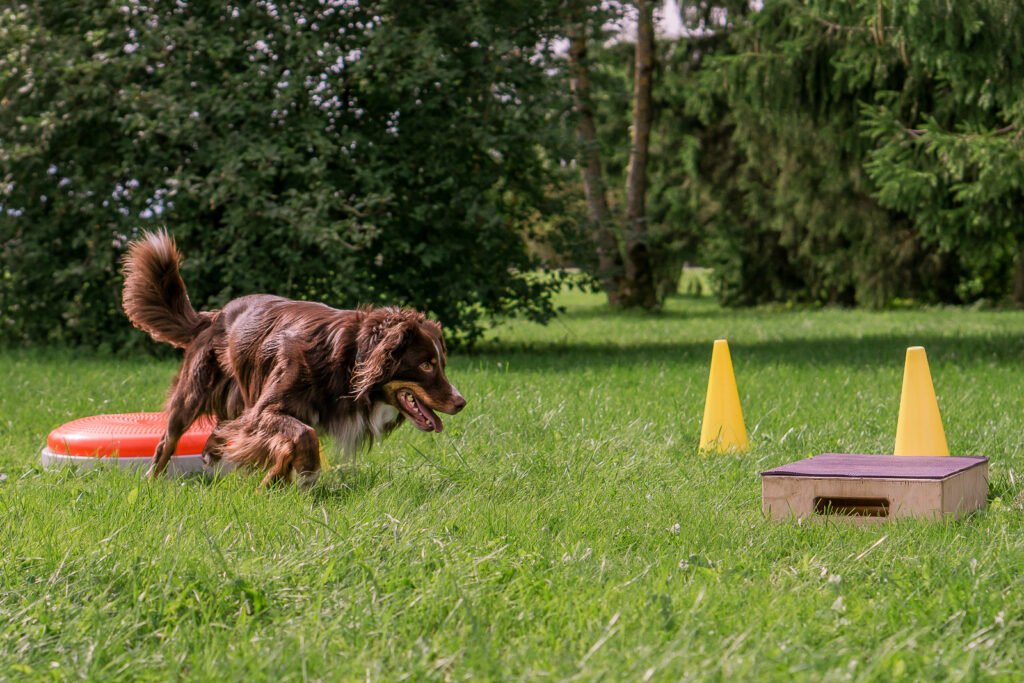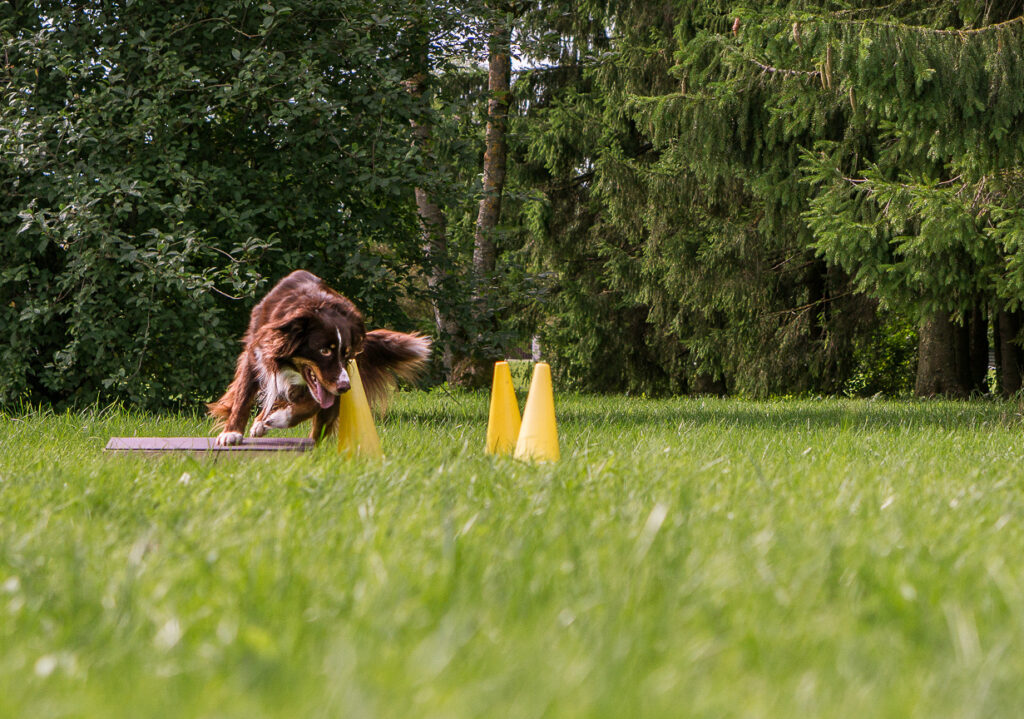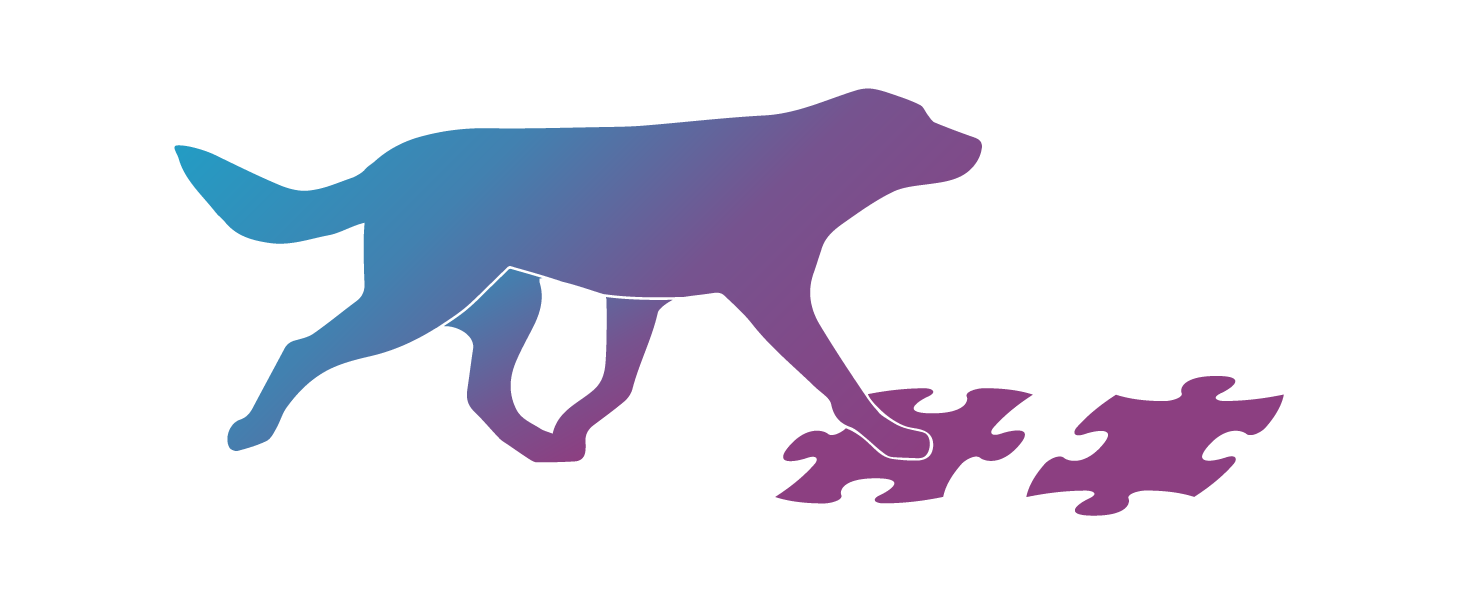Edited to add: since writing this post I’ve gained a lot more experience with teaching Movement Puzzles. I can now say that the 2 bowl game and Vito’s game are taught differently and, as a result, don’t work the same way for Movement Puzzles. The game used for teaching Movement Puzzles is the 2 bowl game, not Vito’s game.
With every training we do with our dogs, we either expect to train new skills for performance, solve some kind of a problem we are facing or avoid a problem in the future. Movement Puzzles and coordination training is no different. This post is all about how Movement Puzzles and coordination training can help your dog!
It may be that you haven’t heard of Movement Puzzles before. Essentially, Movement Puzzles are exercises focusing on various elements of coordination training. By using the 2-bowl game (Vito’s game), we teach our dogs to move between cones and complete various movement challenges independently. We can have running over cavaletti, platforms and balance discs. We can also have advanced elements like crawling, touching small targets and coming to a full stop between the cones. The beauty of these sequences is that our dogs are fully in control of the exercises. Check out the video in the previous post.

The story of the Puzzles
The Movement Puzzles actually started about four years ago when I saw some agility people, instructed by Martina Klimesova, doing whole agility sequences with the two bowl game or Vito’s game. I found this idea really fascinating. If they can do agility training with it, then why can’t we do some fitness training with the two bowl game? Fitness training where the dog would be in charge and move independently between the exercises and gets the treats in the bowl. I had to try it out, of course! And that’s when the very first small puzzles were born, using just one cone and a balance disc.
Fast forward four years and now I have Mr Bo. The handsome young guy you see in the videos and the photos in social media. With Bo I did try doing some agility training and kept running into the fact that Bo finds it really difficult to do tight turns. Especially turning to one side. Every dog has some challenges and I figured if I just carried on with the agility exercises, Bo would learn to use his body better.
I kept pushing forward with the agility exercises until I realized that that’s not how I want to train at all. If I see that my dog is struggling with something, like Bo did with the turns, then I’d like to do something about it. And here I discovered that just fitness training focusing on strength is not enough. Bo has been doing various fitness and body awareness exercises for most of his life (but not Movement Puzzles!). He’s really good with moving his body at low speeds. But when we actually added speed to the exercises where he had to do tight turns, like wrap around the jump wing or enter weave poles, then that was difficult for him.
Poisoned cues kicking in
I left the agility exercises in the background, thinking that we will get back to it once I figured out how to teach Bo better movement skills away from the sport training. One of the big reasons behind it was that I started getting poisoned cues. The turns were uncomfortable enough for Bo to cause uncertainty and confusion during the turns. And this uncertainty transferred into the agility exercises. Every time I asked Bo to do an exercise that included a turn, I could see that he was a bit doubtful before doing that exercise. The cues were getting poisoned due to the lack of physical skills.
I don’t think it’s only Bo’s problem that he’s finding certain elements of movement difficult. I think, just like humans, different dogs find different movement elements difficult. It’s just a matter of whether we notice it or not, and whether we know how to solve it separately from the sports training or not.

It was time to try Movement Puzzles with Bo. Exercises I initially designed to help Bo get better at turning and give him better movement skills away from the sports training. So that I wouldn’t get more poisoned cues! And guess what? We did a few sessions with the specially designed puzzles and Bo’s turning ability became a lot better! Also his movement in the forest running freely became a lot more controlled.
Being in control of the movement is reinforcing
We do want our dogs to become more in control of their body. So that there are no unexpected results from the movement. When Bo was turning to his “bad” side, I could actually see his left hind leg slipping slightly during the turn. I suspect that this was the reason why he found turning so uncomfortable. Maybe it was a physical discomfort or maybe it was the uncertainty of not knowing whether he was going to slip or not. We actually want to remove that uncertainty from the movement.
Being in control of the situation is reinforcing. Similarly, I do think that being in control of movement is actually reinforcing for the dogs. But that means that when the dog is not in control of the movement then that’s not reinforcing. It can even be… aversive for the dogs.
So that’s one of the key things about Movement Puzzles and coordination exercises. We want the dog to become more in control of the movement and that actually can be reinforcing to the learner. We want to build exercises where our learner can focus solely on their own movement, not worry about our cues or any uncertainties. So that they can be better in charge of their bodies during movement and find the best movement patterns for their bodies.
Think about how you’d like to learn new things
If you think about agility and learning a new handling sequence, then it’s often the easiest to try the sequence out first by yourself, without your dog. So that you can really focus on what your hands and legs are doing, where you need to be, and become fluent in your own movement pattern before trying the sequence with your dog.
If you tried the sequence without practicing your own movements first, you will most likely have your hands and legs moving all over the place. And your focus would be only on getting your dog from point A to B.
Now, imagine learning new things from your dog’s point of view. In most dog sport training scenarios, our dogs cannot first practice the movement alone. They have to focus hard to understand what we are asking them to do. The technical part of the exercise. They really can’t focus on planning their movement at the same time! They focus on moving from A to B without having the chance to think about their movement patterns.
Just like we get messy movements when we start running a new handling sequence without practicing it without a dog first. The same happens to our dogs. Essentially they are constantly focusing on getting the work done, but they don’t have the ability or the brainpower to simultaneously think about how exactly they are going to execute the movement from their body perspective. From our own handling sequence example we can guess that this kind of approach leads to poor movement sequence that is all over the place.
That’s why we need coordination training and Movement Puzzles without us in the picture leading to messy movement. This is the only way for our dogs to learn the efficient movement patterns before we start asking sports exercises from them. We need exercises, where dogs can actually focus on their own body and their own movement. And they can figure out what are the best options for them to solve certain movement challenges. It will make sports training more efficient and kinder to the learner’s body. It will remove the chance of physical skill induced poisoned cues in your training. And make training more reinforcing by allowing your dog to be in control of the movement.
That’s it for today’s post. Let me know in the comments if you enjoyed this post 🙂
See you soon!
Happy training!
Mari & Co.
